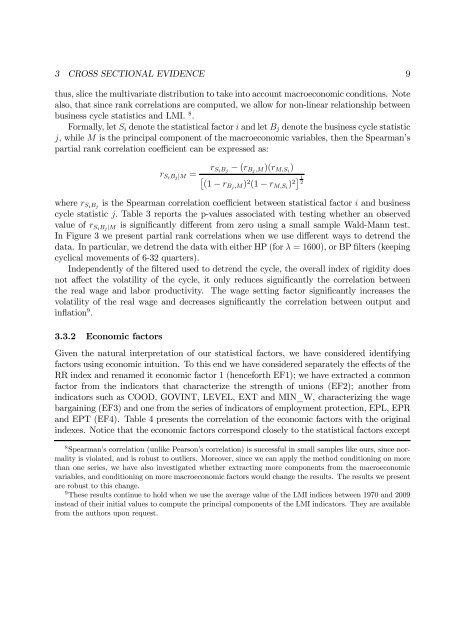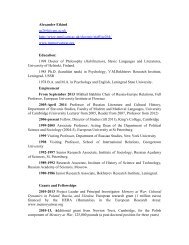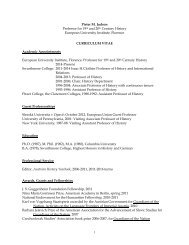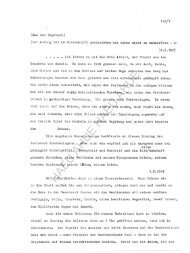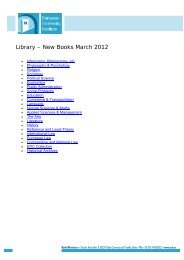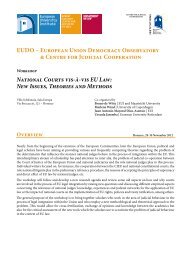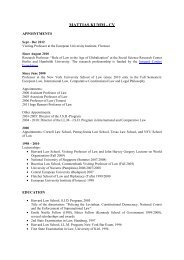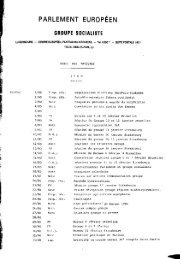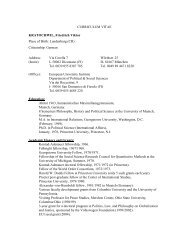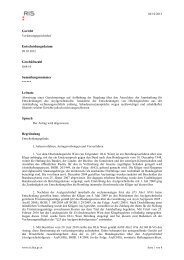Do labor market institutions matter for business cycles?∗ - European ...
Do labor market institutions matter for business cycles?∗ - European ...
Do labor market institutions matter for business cycles?∗ - European ...
You also want an ePaper? Increase the reach of your titles
YUMPU automatically turns print PDFs into web optimized ePapers that Google loves.
3 CROSS SECTIONAL EVIDENCE 9<br />
thus, slice the multivariate distribution to take into account macroeconomic conditions. Note<br />
also, that since rank correlations are computed, we allow <strong>for</strong> non-linear relationship between<br />
<strong>business</strong> cycle statistics and LMI. 8 .<br />
Formally, let S i denote the statistical factor i and let B j denote the <strong>business</strong> cycle statistic<br />
j, while M is the principal component of the macroeconomic variables, then the Spearman’s<br />
partial rank correlation coefficient can be expressed as:<br />
r Si B j |M =<br />
r Si B j<br />
− (r Bj ,M)(r M,Si )<br />
<br />
(1 − rBj ,M) 2 (1 − r M,Si ) 2 1 2<br />
where r Si B j<br />
is the Spearman correlation coefficient between statistical factor i and <strong>business</strong><br />
cycle statistic j. Table 3 reports the p-values associated with testing whether an observed<br />
value of r Si B j |M is significantly different from zero using a small sample Wald-Mann test.<br />
In Figure 3 we present partial rank correlations when we use different ways to detrend the<br />
data. In particular, we detrend the data with either HP (<strong>for</strong> λ = 1600), or BP filters (keeping<br />
cyclical movements of 6-32 quarters).<br />
Independently of the filtered used to detrend the cycle, the overall index of rigidity does<br />
not affect the volatility of the cycle, it only reduces significantly the correlation between<br />
the real wage and <strong>labor</strong> productivity. The wage setting factor significantly increases the<br />
volatility of the real wage and decreases significantly the correlation between output and<br />
inflation 9 .<br />
3.3.2 Economic factors<br />
Given the natural interpretation of our statistical factors, we have considered identifying<br />
factors using economic intuition. To this end we have considered separately the effects of the<br />
RR index and renamed it economic factor 1 (hence<strong>for</strong>th EF1); we have extracted a common<br />
factor from the indicators that characterize the strength of unions (EF2); another from<br />
indicators such as COOD, GOVINT, LEVEL, EXT and MIN_W, characterizing the wage<br />
bargaining (EF3) and one from the series of indicators of employment protection, EPL, EPR<br />
and EPT (EF4). Table 4 presents the correlation of the economic factors with the original<br />
indexes. Notice that the economic factors correspond closely to the statistical factors except<br />
8 Spearman’s correlation (unlike Pearson’s correlation) is successful in small samples like ours, since normality<br />
is violated, and is robust to outliers. Moreover, since we can apply the method conditioning on more<br />
than one series, we have also investigated whether extracting more components from the macroeconomic<br />
variables, and conditioning on more macroeconomic factors would change the results. The results we present<br />
are robust to this change.<br />
9 These results continue to hold when we use the average value of the LMI indices between 1970 and 2009<br />
instead of their initial values to compute the principal components of the LMI indicators. They are available<br />
from the authors upon request.


